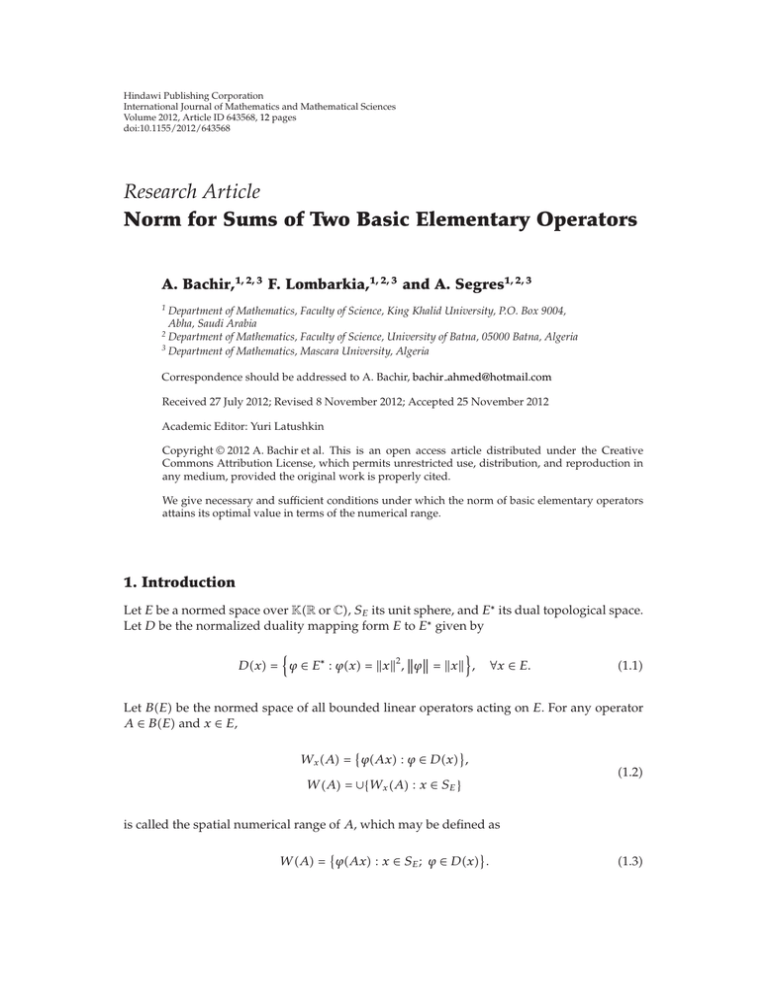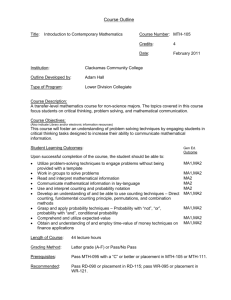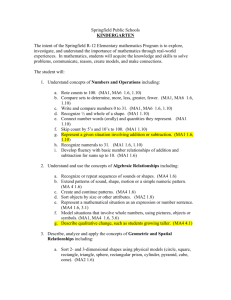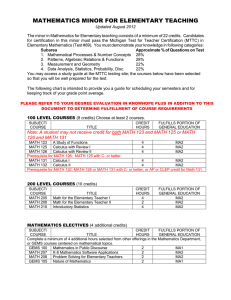Document 10467374
advertisement

Hindawi Publishing Corporation
International Journal of Mathematics and Mathematical Sciences
Volume 2012, Article ID 643568, 12 pages
doi:10.1155/2012/643568
Research Article
Norm for Sums of Two Basic Elementary Operators
A. Bachir,1, 2, 3 F. Lombarkia,1, 2, 3 and A. Segres1, 2, 3
1
Department of Mathematics, Faculty of Science, King Khalid University, P.O. Box 9004,
Abha, Saudi Arabia
2
Department of Mathematics, Faculty of Science, University of Batna, 05000 Batna, Algeria
3
Department of Mathematics, Mascara University, Algeria
Correspondence should be addressed to A. Bachir, bachir ahmed@hotmail.com
Received 27 July 2012; Revised 8 November 2012; Accepted 25 November 2012
Academic Editor: Yuri Latushkin
Copyright q 2012 A. Bachir et al. This is an open access article distributed under the Creative
Commons Attribution License, which permits unrestricted use, distribution, and reproduction in
any medium, provided the original work is properly cited.
We give necessary and sufficient conditions under which the norm of basic elementary operators
attains its optimal value in terms of the numerical range.
1. Introduction
Let E be a normed space over KR or C, SE its unit sphere, and E∗ its dual topological space.
Let D be the normalized duality mapping form E to E∗ given by
Dx ϕ ∈ E∗ : ϕx x2 , ϕ x ,
∀x ∈ E.
1.1
Let BE be the normed space of all bounded linear operators acting on E. For any operator
A ∈ BE and x ∈ E,
Wx A ϕAx : ϕ ∈ Dx ,
WA ∪{Wx A : x ∈ SE }
1.2
is called the spatial numerical range of A, which may be defined as
WA ϕAx : x ∈ SE ; ϕ ∈ Dx .
1.3
2
International Journal of Mathematics and Mathematical Sciences
This definition was extended to arbitrary elements of a normed algebra A by Bonsall 1–3
who defined the numerical range of a ∈ A as
V a WAa ,
1.4
where Aa is the left regular representation of A in BA, that is, Aa ab for all b ∈ A. V a
is known as the algebra numerical range of a ∈ A, and, according to the above definitions,
V a is defined by
V a ϕab : b ∈ SA ; ϕ ∈ Db .
1.5
For an operator A ∈ BE, Bachir and Segres 4 have extended the usual definitions of
numerical range from one operator to two operators in different ways as follows.
The spatial numerical range WAB of A ∈ BE relative to B is
WAB ϕAx : x ∈ SE ; ϕ ∈ DBx .
1.6
The spatial numerical range GAB of A ∈ BE relative to B is
GAB ϕAx : x ∈ E; Bx 1, ϕ ∈ DBx .
1.7
The maximal spatial numerical range of A ∈ BE relative to B is
MAB ϕAx : x ∈ SE ; Bx B, ϕ ∈ DBx .
1.8
For A, B ∈ BE, let SE B {xn n : xn ∈ SE , Bxn → B}, then the set
MAB lim ϕn Axn : xn n ∈ SE B, ϕn ∈ DBxn 1.9
is called the generalized maximal numerical range of A relative to B. It is known that MAB
is a nonempty closed subset of K and MAB ⊆ MAB ⊆ WAB . The definition of MAB
can be rewritten, with respect to the semi-inner product ·, · as
MAB {limAxn , Bxn : xn n ∈ SE B},
1.10
with respect to an inner product ·, · as
MAB {limAxn , Bxn : xn n ∈ SE B}.
1.11
We shall be concerned to estimate the norm of the elementary operator MA1 ,B1 MA2 ,B2 ,
where A1 , A2 , B1 , B2 are bounded linear operators on a normed space E and MA1 ,B1 is the
basic elementary operator defined on BE by
MA1 ,B1 X A1 XB1 .
1.12
International Journal of Mathematics and Mathematical Sciences
3
We also give necessary and sufficient conditions on the operators A1 , A2 , B1 , B2 under which
MA1 ,B1 MA2 ,B2 attaints its optimal value A1 B1 A2 B2 .
2. Equality of Norms
Our next aim is to give necessary and sufficient conditions on the set {A1 , A2 , B1 , B2 } of
operators for which the norm of MA1 ,B1 MA2 ,B2 equals A1 B1 A2 B2 .
Lemma 2.1. For any of the operators A, B, C ∈ BE and all α, β ∈ K, one has
M αA βB B αMAB βB2 ;
M αA βC B ⊆ αMAB βMCB .
2.1
Proof. The proof is elementary.
Theorem 2.2. Let A1 , A2 , B1 , B2 be operators in BE.
If A1 A2 ∈ MA1 A2 ∪ MA2 A1 and B1 B2 ∈ MB1 B2 ∪ MB2 B1 , then
MA1 ,B1 MA2 ,B2 A1 B1 A2 B2 .
2.2
Proof. The proof will be done in four steps; we choose one and the others will be proved
similarly. Suppose that A1 A2 ∈ MA1 A2 and B1 B2 ∈ MB1 B2 , then there exist
xn n ∈ SE A2 , ϕn ∈ DA2 xn such that A1 A2 limn ϕn A1 xn and there exist yn n ∈
SE B2 , ψn ∈ DB2 yn such that B1 B2 limn ψn B1 yn . Define the operators Xn ∈ BE as
follows:
Xn yn ψn ⊗ xn yn ψn yn xn ,
∀n.
2.3
Then Xn ≤ B2 , for all n ≥ 1, and
MA B MA B Xn yn A1 Xn B1 A2 Xn B2 yn 1
1
2
2
A1 Xn B1 yn A2 Xn B2 yn ϕn A1 ψn B1 yn xn A2 ψn B2 yn xn ϕn 1 ≥ ϕn ψn B1 yn A1 xn ψn B2 yn A2 xn ϕn MA1 ,B1
2
1 ψn B1 yn ϕn A1 xn B2 yn A2 xn 2 .
ϕn MA ,B MA ,B Xn yn 1 1
2 2
MA2 ,B2 ≥
, ∀n ≥ 1.
Xn 2.4
2.5
4
International Journal of Mathematics and Mathematical Sciences
Hence
MA1 ,B1 MA2 ,B2 ≥
2
ψn B1 yn ϕn A1 xn B2 yn A2 xn 2 A2 B2 ,
∀n ≥ 1.
2.6
Letting n → ∞,
MA1 ,B1 MA2 ,B2 ≥ A1 B1 A2 B2 .
2.7
MA1 ,B1 MA2 ,B2 ≤ A1 B1 A2 B2 ,
2.8
MA1 ,B1 MA2 ,B2 A1 B1 A2 B2 .
2.9
Since
therefore
Corollary 2.3. Let E be a normed space and A, B ∈ BE. Then, the following assertions hold:
1 if AB ∈ MAB , then A B A B;
2 if A ∈ MIA and B ∈ MIB , then MA,B I 1 AB.
Remark 2.4. In the previous corollary, if we set B I, then we obtain an important equation
called the Daugavet equation:
A I 1 A.
2.10
It is well known that every compact operator on C0, 1 5 or on L1 0, 1 6 satisfies 2.10.
A Banach space E is said to have the Daugavet property if every rank-one operator on
E satisfies 2.10. So that from our Corollary 2.3 if 1 ∈ MIA or 1 ∈ MAI for every rank-one
operator A, then E has the Daugavet property.
The reverse implication in the previous theorem is not true, in general, as shown in the
following example which is a modification of that given by the authors Bachir and Segres 4,
Example 3.17.
Example 2.5. Let c0 be the classical space of sequences xn n ⊂ C : xn → 0, equipped with
the norm xn n maxn |xn | and let L be an infinite-dimensional Banach space. Taking the
Banach space E L ⊕ c0 equipped with the norm, for x x1 x2 ∈ E, x x1 x2 max{x1 , T x1 x2 }, where T is any norm-one operator from L to c0 which does not attain
its norm by Josefson-Nissenzweig’s theorem 7, we can find a sequence ϕn n ⊂ SE∗ such
that ϕn converges weakly to 0. Therefore we get the desired operator T : L → c0 defined by
T xn n
ϕn x.
n1
2.11
International Journal of Mathematics and Mathematical Sciences
5
Let A1 , A2 , B1 , B2 be operators defined on E as follows:
A1 x1 x2 0 T x1 ;
A2 x A2 x1 x2 x1 0;
B1 x1 x2 x1 − x2 ;
B2 I,
2.12
∀x x1 x2 ∈ L × c0 ,
where I is the identity operator on E. It easy to check that A1 , A2 , B1 are linear bounded
operators and A1 A2 B1 B2 1. If we choose X0 I and x0 x1 0 such that
1 T x1 ≥ x1 , then X0 x0 1 and
MA1 ,B1 MA2 ,B2 ≥ MA1 ,B1 MA2 ,B2 X0 x0 A1 X0 B1 A2 X0 B2 x0 0 T x1 x1 0
2.13
max{x1 , 2T x1 }
2,
and from
MA1 ,B1 MA2 ,B2 ≤ A1 A2 B1 B2 2
2.14
MA1 ,B1 MA2 ,B2 2 A1 A2 B1 B2 .
2.15
we get
It is clear from the definitions of MA1 A2 and WA1 A2 that
MA1 A2 ⊆ WA1 A2
2.16
for details, see 4.
The next result shows that the reverse is true under certain conditions, before that we
recall the definition of Birkhoff-James orthogonality in normed spaces.
Definition 2.6. Let E be a normed space and x, y ∈ E. We say that x is orthogonal to y in the
sense of Birkhoff-James 8, 9, in short x ⊥B−J y , iff
∀λ ∈ K : x λy ≥ x.
2.17
If F, G are linear subspaces of E, we say that F is orthogonal to G in the sense of ⊥B−J ,
written as F ⊥B−J G iff x ⊥B−J y for all x ∈ F and all y ∈ G.
6
International Journal of Mathematics and Mathematical Sciences
If T ∈ BE, we will denote by RanT and T † the range and the dual adjoint,
respectively, of the operator T .
Theorem 2.7. Let A1 , A2 , B1 , B2 be operators in BE.
If MA1 ,B1 MA2 ,B2 A1 B1 A2 B2 ,
A1 †
†
†
Ran A2 ⊥B−J Ran A1 −
A2 ,
A2 Ran B2 ⊥B−J Ran
B1 B1 −
B2 ,
B2 2.18
then
†
A1 A2 ∈ M A1 † ,
A2
B1 B2 ∈ MB1 B2 .
2.19
Moreover, if
A2 †
†
†
Ran A1 ⊥B−J Ran A2 −
A ,
A1 1
Ran B1 ⊥B−J
B2 Ran B2 −
B1 ,
B1 2.20
then
†
A1 A2 ∈ M A1
†
A2
†
∩ M A2 † ,
A1
B1 B2 ∈ MB1 B2 ∩ MB2 B1 .
2.21
Proof. If MA1 ,B1 MA2 ,B2 A1 B1 A2 B2 , then we can find two normalized sequences
Xn n ⊆ BE and xn n ⊆ E such that
limA1 Xn B1 xn A2 Xn B2 xn A1 B1 A2 B2 .
n
2.22
We have for all n ≥ 1
A1 Xn B1 xn ≤ A1 B1 xn ≤ A1 B1 A2 Xn B2 xn ≤ A2 B2 xn ≤ A2 B2 ,
2.23
so we can deduce from the above inequalities and 2.10 that limn B1 xn B1 and
limn B2 xn B2 . From the assumptions RanB2 ⊥B−J RanB1 − B1 /B2 B2 we get
B1 Ran B1 −
B2 ∩ RanB2 {0}.
B2 2.24
Set χn B1 − B1 /B2 B2 xn and yn B2 xn for all n and define the function φn on the
closed subspace F spanned by {xn , yn } for all n as
2
φn aχn byn byn bB2 xn ,
∀a, b ∈ K.
2.25
International Journal of Mathematics and Mathematical Sciences
7
It is clear that φn is linear for all n and
byn φn aχn byn |b|B2 xn 2 aχn byn B2 xn .
aχn byn 2.26
From the assumptions RanB2 ⊥B−J RanB1 − B1 /B2 B2 it follows that
φ aχn byn ≤ B2 xn aχn byn ,
∀a, b ∈ K, ∀n.
2.27
This means that φn is continuous for each n on the subspace F with φn B2 xn by 2.27
n ∈ E∗ with φ
n |F φn
and φn yn yn B2 xn . Then by Hahn-Banach theorem there is φ
and φn φn , for each n. So
n χn φ
n
φ
B1 B2 xn 0,
B1 −
B2 2.28
hence
n χn φ
n
limφ
B1 −
n
n B2 xn B2 xn 2 ,
φ
B1 B2 xn 0,
B2 φn B2 xn .
2.29
Thus, 0 ∈ MB1 − B1 /B2 B2 B2 and by Lemma 2.1
0∈
MB1 B2 −
B1 B2 2
B2 MB1 B2 − B1 B2 .
2.30
Therefore,
B1 B2 ∈ MB1 B2 .
2.31
From MA1 ,B1 MA2 ,B2 A1 B1 A2 B2 we can find a normalized sequences
Xn n ⊆ BE such that
limA1 Xn B1 A2 Xn B2 A1 B1 A2 B2 .
n
†
†
†
†
†
2.32
†
Since A1 Xn B1 A2 Xn B2 B1 Xn A1 B2 Xn A2 , for each n, then we can find a normalized
φnk ∈ E† such that
† † †
† † †
limB1 Xn A1 φnk B2 Xn A2 φnk A1 B1 A2 B2 .
k,n
2.33
8
International Journal of Mathematics and Mathematical Sciences
We argue similarly and get
† †
limA1 φnk A1 ,
k,n
† †
limA2 φnk A2 .
2.34
k,n
†
Following the same steps as in the previous case we obtain A1 A2 ∈ MA1 A† .
†
†
†
2
Moreover, if we have RanA1 ⊥B−J RanA2 − A2 /A1 A1 and RanB1 ⊥B−J
RanB2 − B2 /B1 B1 , it suffices to reverse, in the proof of the previous case, the role
†
†
of A1 into A2 and B1 into B2 .
For the completeness of the previous theorem we need to prove the following result
which is very interesting.
We recall that Phelps 10 has proved that, for a Banach space E, ∪{Dx : x ∈ E} is
dense in E∗ ; this property is called subreflexivity of the space E. Using this fact, Bonsall and
Duncan 2 has proved that for any operator T ∈ BE we have WT WT † . The following
result generalizes the Bollobas result in the case MAB , where A, B ∈ BE.
Proposition 2.8. Let E be a Banach space with smooth dual and let A, B ∈ BE such that B is a
surjective operator. Then MA† B† ⊆ MAB .
Proof. Let a ∈ MA† B† , then there are ψn ∈ DB† ϕn , ϕn n ∈ SE∗ B† such that a limn ψn A† ϕn .
By the subreflexivity of E there exist sequences ϕnk nk ⊆ E∗ and xnk ⊆ E such that
ϕnk ∈ Dxnk and ϕnk − Bxnk ϕn to 0. It follows that the sequence xnk ⊆ E∗∗ has an
E∗∗ -weak convergent subsequence xnm nm , that is,
xnm f −→ Ψ f ,
∀f ∈ E∗ , Ψ ∈ E∗∗ .
2.35
On the one hand, we have
Bxnm 2 B† ϕnm − Bxnm ϕn xnm Bxnm B† ϕn xnm .
2.36
Bxnm 2 ≤ B† ϕnm − Bxnm ϕn Bxnm B† ϕn .
2.37
Bxnm Bxnm − B† ϕn ≤ B† ϕnm − Bxnm ϕn .
2.38
Then
Thus
International Journal of Mathematics and Mathematical Sciences
9
On the other hand,
B† ϕnm † †
†
xnm B ϕn − B ϕn ≤ xnm B ϕn − xnm
Bxnm 1
xnm B† ϕnm − B† ϕn Bxnm 1
x B† ϕn −
B† ϕnm Bxnm − B† ϕn Bxnm −→ 0
2.39
as m −→ ∞.
So limm xnm B† ϕn B† ϕn and B† ϕn Ψn ∈ DB† ϕn . Then by smoothness of the space E∗
we get B† ϕn Ψn Ψn , for all n. Next,
Bxn m
†
†
ψn A ϕn ≤ xnm A† ϕnm − xnm Bxnm A† ϕn xnm A ϕnm − B† ϕn 1
†
†
Bxnm xnm A ϕn − † ψn A ϕn B ϕn xnm A† ϕnm − A† ϕn Bxnm xnm A† ϕn − ψn A† ϕn −→ 0
2.40
as m −→ ∞.
Then limm xnm A† ϕnm ψn A† ϕn or limm ϕnm Axnm ψA† ϕn and therefore
lim lim ϕnm Axnm lim ψn A† ϕn a
n
m
n
2.41
which means that a ∈ MAB .
Corollary 2.9. Let E be a Banach space with smooth dual and A1 , A2 , B1 , B2 ∈ BE.
†
†
If MA1 ,B1 MA2 ,B2 A1 B1 A2 B2 and RanA2 ⊥B−J RanA1 − A1 /
†
A2 A2 with A2 being surjective, and RanB2 ⊥B−J RanB1 − B1 /B2 B2 , then
A1 A2 ∈ MA1 A2 ,
†
†
B1 B2 ∈ MB1 B2 .
2.42
†
Moreover, if RanA1 ⊥B−J Ran A2 − A2 /A1 A1 , A2 is surjective, and RanB1 ⊥B−J
RanB2 − B2 /B1 B1 , then
A1 A2 ∈ MA1 A2 ∩ MA2 A1 ,
B1 B2 ∈ MB1 B2 ∩ MB2 B1 .
2.43
10
International Journal of Mathematics and Mathematical Sciences
Corollary 2.10. Let E be a Banach space with smooth dual and A1 , A2 , B1 , B2 ∈ BE such that
†
†
†
A1 , A2 are surjective operators. If RanAi ⊥B−J RanAj − Aj /Ai Ai and RanBi ⊥B−J
Ran Bj − Bj /Bi Bi , i, j 1, 2 such that i /
j then the following assertions are equivalent:
1 MA1 ,B1 MA2 ,B2 A1 B1 A2 B2 ;
2 A1 A2 ∈ MA1 A2 ∩ MA2 A1 and B1 B2 ∈ MB1 B2 ∩ MB2 B1 .
As a particular case, we obtain the following.
Corollary 2.11. Let E be a Banach space with smooth dual and A, B are surjective operators in BH.
If
A †
Ran B† ⊥B−J Ran A† −
B ,
B
B
A ,
RanA⊥B−J Ran B −
A
2.44
then the following assertions are equivalent:
1 AB ∈ MAB ∩ MBA ;
2 MA,B MB,A 2AB.
3. Hilbert Space Case
Let E H be a complex Hilbert space and A ∈ BH. The maximal numerical range of A
11 denoted by W0 A is defined by
{λ ∈ C : ∃xn , xn 1, such that limAxn , xn λ and limAxn A},
3.1
and its normalized maximal range, denoted by WN A, is given by
⎧ ⎨W0 A
if A /0
A
WN A ⎩
0
if A 0.
3.2
The set W0 A is nonempty, closed, convex, and contained in the closure of the numerical
range of A.
In this section we prove that if E H, the conditions
A1 A2 ∈ MA1 A2 ∩ MA2 A1 ,
B1 B2 ∈ MB1 B2 ∩ MB2 B1
3.3
would imply that
∗ A A1 A1 A2 ,
B2 B∗ B1 B2 ,
2
1
∅.
WN A∗2 A1 ∩ WN B2 B1∗ /
3.4
International Journal of Mathematics and Mathematical Sciences
11
Proposition 3.1. Let H be a complex Hilbert space, A1 , A2 , B1 , B2 ∈ BH.
If A1 A2 ∈ MA1 A2 ∩MA2 A1 and B1 B2 ∈ MB1 B2 ∩MB2 B1 , then A∗2 A1 ∅.
A1 A2 and B2 B1∗ B1 B2 and WN A∗2 A1 ∩ WN B2 B1∗ /
Proof. If A1 0 or A2 0 and B1 0 or B2 0, the result is obvious.
The proof will be done in four steps, we choose one and the others will be proved
0 and A2 /
0, if A1 A2 ∈ MA1 A2 , then there exists a sequence
similarly. Suppose that A1 /
xn n ∈ SH A2 such that
A1 A2 limA1 xn , A2 xn .
3.5
We have |A∗2 A1 xn , xn | ≤ A∗2 A1 ≤ A1 A2 ; this yields
limA∗2 A1 xn A∗2 A1 A1 A2 .
3.6
From 3.5 and 3.6 we get
∗ A A1 A1 A2 ,
2
1 ∈ W0
A∗ A1
2∗ A A1 .
3.7
2
Suppose now that B1 /
0 and B2 /
0, if B1 B2 ∈ MB1 B2 , then there exists a sequence
yn n ∈ SH B2 such that
B1 B2 limB1 yn , B2 yn .
3.8
Since limn B1 yn B1 , then limn B1∗ B1 yn − B1 2 yn 0.
Suppose that wn B1 yn /B1 , then yn B1∗ wn /B1 zn such that limn zn 0.
Hence
B2 yn , B1 yn
B1∗ wn
, B1 wn
B2
B1 B2 B1∗ wn , wn B2 zn , B1 wn .
3.9
From this, we derive that
limB2 B1∗ wn B2 B1∗ B1 B2 .
3.10
From 3.8 and 3.10 we have
B2 B∗ B1 B2 ,
1
1 ∈ W0
B2 B1∗
B2 B∗ .
3.11
1
From 3.7 and 3.11 we get A∗2 A1 A1 A2 and B2 B1∗ B1 B2 and WN A∗2 A1 ∩
∅.
WN B2 B1∗ /
12
International Journal of Mathematics and Mathematical Sciences
Remark 3.2. We remark that in the case E H we obtain an implication given by Boumazgour
12.
Acknowledgments
The authors would like to sincerely thank the anonymous referees for their valuable
comments which improved the paper. This research was supported by a grant from King
Khalid University no. KKU S130 33.
References
1 F. F. Bonsall and J. Duncan, Numerical Ranges of Operators on Normed Spaces and of Elements of
Normed Algebras, vol. 2 of London Mathematical Society Lecture Note Series, Cambridge University Press,
London, UK, 1971.
2 F. F. Bonsall and J. Duncan, Numerical Ranges. II, vol. 2, Cambridge University Press, New York, NY,
USA, 1973.
3 F. F. Bonsall, “The numerical range of an element of a normed algebra,” Glasgow Mathematical Journal,
vol. 10, pp. 68–72, 1969.
4 A. Bachir and A. Segres, “Numerical range and orthogonality in normed spaces,” Filomat, vol. 23, no.
1, pp. 21–41, 2009.
5 I. K. Daugavet, “A property of completely continuous operators in the space C,” Uspekhi
Matematicheskikh Nauk, vol. 18, no. 5, pp. 157–158, 1963 Russian.
6 G. Ja. Lozanovskiı̆, “On almost integral operators in KB-spaces,” Vestnik Leningrad University.
Mathematics, vol. 21, no. 7, pp. 35–44, 1966.
7 J. Diestel, Sequences and Series in Banach Spaces, vol. 92 of Graduate Texts in Mathematics, Springer, New
York, NY, USA, 1984.
8 G. Birkhoff, “Orthogonality in linear metric spaces,” Duke Mathematical Journal, vol. 1, no. 2, pp. 169–
172, 1935.
9 R. C. James, “Orthogonality and linear functionals in normed linear spaces,” Transactions of the
American Mathematical Society, vol. 61, pp. 265–292, 1947.
10 R. R. Phelps, Convex Functions, Monotone Operators and Differentiability, vol. 1364 of Lecture Notes in
Mathematics, Springer, Berlin, Germnay, 2nd edition, 1993.
11 J. G. Stampfli, “The norm of a derivation,” Pacific Journal of Mathematics, vol. 33, pp. 737–747, 1970.
12 M. Boumazgour, “Norm inequalities for sums of two basic elementary operators,” Journal of
Mathematical Analysis and Applications, vol. 342, no. 1, pp. 386–393, 2008.
Advances in
Operations Research
Hindawi Publishing Corporation
http://www.hindawi.com
Volume 2014
Advances in
Decision Sciences
Hindawi Publishing Corporation
http://www.hindawi.com
Volume 2014
Mathematical Problems
in Engineering
Hindawi Publishing Corporation
http://www.hindawi.com
Volume 2014
Journal of
Algebra
Hindawi Publishing Corporation
http://www.hindawi.com
Probability and Statistics
Volume 2014
The Scientific
World Journal
Hindawi Publishing Corporation
http://www.hindawi.com
Hindawi Publishing Corporation
http://www.hindawi.com
Volume 2014
International Journal of
Differential Equations
Hindawi Publishing Corporation
http://www.hindawi.com
Volume 2014
Volume 2014
Submit your manuscripts at
http://www.hindawi.com
International Journal of
Advances in
Combinatorics
Hindawi Publishing Corporation
http://www.hindawi.com
Mathematical Physics
Hindawi Publishing Corporation
http://www.hindawi.com
Volume 2014
Journal of
Complex Analysis
Hindawi Publishing Corporation
http://www.hindawi.com
Volume 2014
International
Journal of
Mathematics and
Mathematical
Sciences
Journal of
Hindawi Publishing Corporation
http://www.hindawi.com
Stochastic Analysis
Abstract and
Applied Analysis
Hindawi Publishing Corporation
http://www.hindawi.com
Hindawi Publishing Corporation
http://www.hindawi.com
International Journal of
Mathematics
Volume 2014
Volume 2014
Discrete Dynamics in
Nature and Society
Volume 2014
Volume 2014
Journal of
Journal of
Discrete Mathematics
Journal of
Volume 2014
Hindawi Publishing Corporation
http://www.hindawi.com
Applied Mathematics
Journal of
Function Spaces
Hindawi Publishing Corporation
http://www.hindawi.com
Volume 2014
Hindawi Publishing Corporation
http://www.hindawi.com
Volume 2014
Hindawi Publishing Corporation
http://www.hindawi.com
Volume 2014
Optimization
Hindawi Publishing Corporation
http://www.hindawi.com
Volume 2014
Hindawi Publishing Corporation
http://www.hindawi.com
Volume 2014







